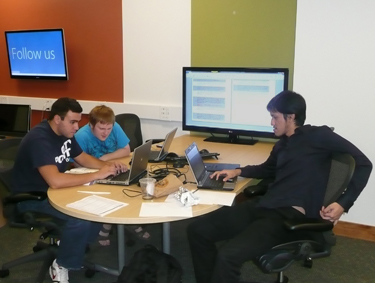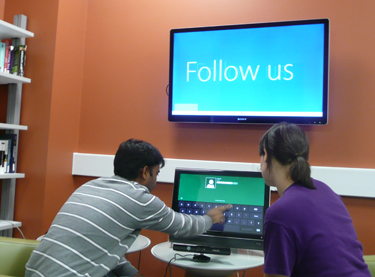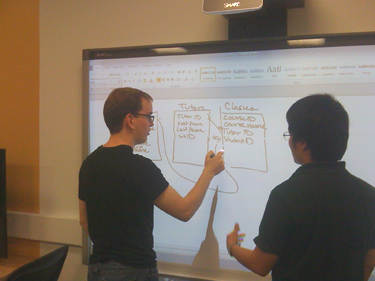From Computer Lab to Sandbox
Under Mark Frydenberg’s direction, the old, traditional Computer Information Systems laboratory at Bentley University has been transformed into a unique “Sandbox” with state-of-the art technology-enhanced collaboration spaces--both physical and virtual--that support formal and informal learning and discovery.
Bentley University, in Waltham, MA opened its redesigned, refurbished CIS lab Sept. 26, unveiling not only new furnishings and equipment, but a whole new philosophy and practice as well.
Now called "the Sandbox," what was once a traditional computer lab with PCs lining the walls is now a collaborative environment equipped with several different learning spaces, a virtual presence, and a range of technologies that not only support curricular studies in Computer Information Systems department courses but also invite extracurricular explorations. Sandbox staffers offer tutoring and answers to technology questions and also support independent inquiries and peer group projects that go beyond CIS course requirements.
Mark Frydenberg, a senior lecturer in CIS at Bentley, was the driving force behind the makeover. Campus Technology spoke with Frydenberg shortly after the opening of the new Sandbox to ask him about the implementation of technology-enabled collaborative workspaces--both on the ground and virtual--and their importance in recasting the role of the lab as a sandbox for formal and informal student learning.
Mary Grush: Why did you rethink Bentley's CIS lab, and what are some of the main differences or departures from your old lab? How is it now a sandbox?
Mark Frydenberg: Every university has a computer lab. When asked to oversee the CIS Lab at Bentley, I knew that I wanted ours to become an informal place that supported learning and discovery not only about course-related topics but also about the Web and technology in general.
In industry, the term "sandbox" refers to an environment for experimentation and trying new things. That's our vision--to create an inviting, collaborative space for exploring and learning new technologies and to support student learning for our courses in ways that resonate with today's digital students. We chose that name--the Sandbox--for our facility.
| | 
A tutor helps students with an assignment in the CIS Sandbox. | |
Grush: What were some of key features you built into the Sandbox design--physical or online?
Frydenberg: We worked with Bentley's Academic Technology Center to renovate the physical space to make it more inviting. [Editor's note: Watch a time-lapse view of the renovation at cis.bentley.edu.]
We improved the lighting and painted bright colors on the walls at each of the tables for individual or group work. One table is designated for students seeking help with their courses. When lab assistants aren't tutoring, the large screen at that table displays the names and photos of those who are currently on duty, so students can easily find them. Twelve desktop computers are available for students who need to use the specialized application development, network analysis, and Web design software available only in this room.
It was important to me that the Sandbox offers an area of comfortable, easily movable seating for informal conversations. Sometimes the best learning takes place when people talk to each other, without looking at a computer screen.
To help students and faculty connect with the Sandbox, we needed to create an online presence that would support the operation of the physical space. A WordPress blog at cis.bentley.edu/sandbox tells the story of "what's happening in the Sandbox." It's the place online where students and faculty go to see who's working, and also where tutors can share resources and ideas.
We use a Google group for internal communications among the lab staff and a Google site for creating, gathering, and sharing information about policies and procedures and how to use the technologies and equipment in the room. It's important to record this information online so we have it to pass along before students who master a particular technology graduate! Student workers also post their weekly activity reports to the Google site. The students who staff the Sandbox keep their hours on Google Calendar, and a widget pulls in the schedule for the day, so the schedule on the blog is always up to date.
To ensure that we have statistics of usage, we developed a swipe-in system for students to sign in using their student IDs. This also lets us keep track of busier times and adjust staffing accordingly. After they swipe in, names of the students automatically appear in an online tutor activity form, so at the end of their shifts tutors can easily log their tutoring activity. Each week, faculty members receive a summary report by e-mail showing the questions their students asked when they came to the Sandbox for help.
| | 
Students explore the Windows 8 touch interface. | |
Grush: Please talk a little more about the collaborative aspects of the Sandbox. What's the nature of the collaborations that you are expecting to see, and how does the Sandbox support them?
Frydenberg: Group projects are very popular in many courses at Bentley, and we've designed this lab to facilitate students' work together. We learned from the successes of other specialty learning labs on campus. In the Sandbox we created four collaboration stations with long tables and large monitors, so students working around the table can either just use the PC at that table or share their laptop's screen with the group. So far, this configuration has been helpful for students learning Excel and Java programming, as they can all look at the same spreadsheet formulas or code together. Some groups have used Google Docs to collaboratively write outlines and project plans.
Grush: What is the role of the tutors in the Sandbox? Are they available to support informal student collaborations? Is there a line between informal collaborations and "official," formally supported tutoring?
Frydenberg: I'd really like to think of the Sandbox as a learning lab, not a tutoring lab. Tutoring implies that you go there only when you're having trouble or need help in a class. Everyone has something to learn, whether they're the best student or one who needs a bit of help and encouragement.
Our lab staff primarily help students review course concepts so they can complete homework and other assignments in their Introduction to IT, programming, database, Web development, and other courses. That's their official role and top priority. They also field questions like: "How do I read e-mail on my iPhone?" or "How do I forward my Bentley e-mail to my Gmail account?" or "How can I add gadgets to my Web page?" or "How do I set up wireless on my laptop?"
They use the time when they're working but not helping students to take on special projects. To give you a quick glimpse of what some of the students are working on now (this will keep changing): Matt is responsible for updating the Prezi that displays on the Google TV each week with new information that is provided to him. Dylan has been working on a more user-friendly layout for the WordPress site. Michelle monitors our lab usage and generates reports for faculty. Dmitry, Hima, Nilam, Chace, and Conner are all preparing workshops on new features of Office 2010 to share with students and faculty this fall and hope to offer workshops later in the semester on extracurricular topics, such as "how to use social media tools to promote your student organization" and "cool free software you should know about." Avinash oversees our Windows 8 test bed, and Kunal and Matt set up the Xbox and were very excited to test the games we have. (Now they're looking into doing their own Xbox development and hope to share what they learn with other students in a workshop later this year.)
Grush: What are a few of the other available technologies, and how do you see them contributing to "productive play," if you will, or student explorations in the Sandbox?
Frydenberg: I mentioned the Google TVs, and the Xbox and several software titles and development software that Microsoft donated for students to explore application development on that platform. We set up a Smart Board in the presentation area which doubles as a computer projector for small group workshops.
The Sandbox has some specialized networking equipment used by our networking class. Students were interested in finding out more about Windows 8, so we set aside a few machines on which they could install the development version of Microsoft's new operating system to explore.
| | 
Students work together to design a database using the Smart Board in the CIS Sandbox. | |
Grush: It's interesting that you have included an online element in the Sandbox--so it's not only an in-place learning space. What online tools will especially aid or promote learning in this Sandbox?
Frydenberg: Sandbox staff are asked to blog about twice a month about what they're working on or frequently asked questions they get from students who come in for help or other interests they have with technology, so that there's almost always something new on the site. This helps students get to know them better as well. Their regular posts help create a community where students learn from each other about curricular as well as extra-curricular technology issues.
We are beginning to develop a social media strategy, which includes setting up Facebook and Twitter pages and using Facebook events to invite classmates and friends to workshops.
A chat widget from Meebo embedded on the front page of the Sandbox blog lets students chat with lab assistants from whereever they are to ask quick questions or to find out if someone is available. We're also beginning to explore using Skype and screen sharing to offer help to students who can't make it to the Sandbox in person.
Grush: Is there a big shift that you can observe in general, from an isolationist learning style to a more collaborative one? Are students really different now, in this respect, than in previous decades?
Frydenberg: Students are more connected now than ever before, often with more than one device at a time. They're connected with their peers through social networks and text messages; they're connected with the world through Internet browsers that run on their phones and their mobile computers. They have a natural inclination to share--so we wanted to support that with large screens on which their work or their questions could take center stage.
We removed most of the desktop computers as part of the renovation after realizing that most students would rather use their own laptops.
Grush: How important is it for institutions to plan collaborative learning spaces for students? Are these spaces needed throughout the disciplines?
Frydenberg: It's incredibly important for institutions to plan collaborative learning spaces for students. The Bentley library has several collaborative study rooms and an Internet Cafe. Bentley has signature technology labs for learning financial services, accounting and business measurement, and media and culture. There are centers for marketing technology, and design and usability. We also have facilities that support writing, mathematics, and languages. We're pleased that the CIS Sandbox is joining this impressive collection of high-tech labs as a state-of-the-art physical and virtual space for students to explore information technology.